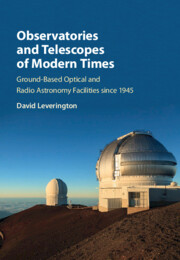 Observatories and Telescopes of Modern Times
Observatories and Telescopes of Modern Times from Part 1 - Optical Observatories
Published online by Cambridge University Press: 15 December 2016
Introduction
Hawaii was an important location for geophysical and astronomical observations during the International Geophysical Year (IGY) of 1957–58 because of its relative isolation in the middle of the Pacific Ocean. As a result, a number of such observations were planned but, unfortunately, there was not enough time nor money to establish all the facilities required. For example Walter Steiger of the University of Hawaiʻi (UH) had been hoping to establish a solar observatory in Hawaii, and in 1955 he had started site testing at the top of the 3,060 m (10,040 ft) high Haleakala, a virtually extinct volcano on the island of Maui. These tests indicated that Haleakala would be an ideal location for a solar observatory, but because of financial and timescale limitations Steiger had to settle, instead, for establishing a sea-level observatory on the island of Oahu.
Fred Whipple had also asked if the UH could build a satellite tracking station on Haleakala for the duration of the IGY. In this case he arranged for money to be provided in a rather round about way. He persuaded his old friend Kenneth Mees, a retired senior executive of Kodak and photographic scientist, to donate a number of Kodak plates to the UH so they could sell them and use the money to establish the tracking station. As a result the UH was able to acquire a plot of land on the summit not only for the satellite tracking station, which became operational in 1957, but, hopefully, to accommodate a future solar observatory there. At about the same time the United States Weather Bureau/National Bureau of Standards established an atmospheric research station at 11,120 ft (3,390 m) on the relatively stable northern slope of the active volcano Mauna Loa on the main island of Hawaii. Finally groundbreaking took place in February 1962 for the solar observatory on Haleakala. Dedicated two years later it was named the C.E. Kenneth Mees Solar Observatory in honour of the former Kodak senior executive.
Mitsuo Akiyama of the Hawaii Chamber of Commerce sent letters to many American and Japanese Universities in June 1963 suggesting that they consider the possibility of setting up an astronomical observatory on either of Hawaii's two large volcanoes, Mauna Kea and Mauna Loa.(1)
To save this book to your Kindle, first ensure [email protected] is added to your Approved Personal Document E-mail List under your Personal Document Settings on the Manage Your Content and Devices page of your Amazon account. Then enter the ‘name’ part of your Kindle email address below. Find out more about saving to your Kindle.
Note you can select to save to either the @free.kindle.com or @kindle.com variations. ‘@free.kindle.com’ emails are free but can only be saved to your device when it is connected to wi-fi. ‘@kindle.com’ emails can be delivered even when you are not connected to wi-fi, but note that service fees apply.
Find out more about the Kindle Personal Document Service.
To save content items to your account, please confirm that you agree to abide by our usage policies. If this is the first time you use this feature, you will be asked to authorise Cambridge Core to connect with your account. Find out more about saving content to Dropbox.
To save content items to your account, please confirm that you agree to abide by our usage policies. If this is the first time you use this feature, you will be asked to authorise Cambridge Core to connect with your account. Find out more about saving content to Google Drive.